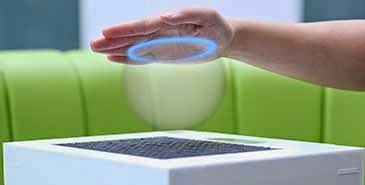New research, using ultrasound, has developed a virtual 3D haptic shape that can be seen and felt.
The method uses ultrasound, which is focused onto hands above the device and that can be felt. By focusing complex patterns of ultrasound, the air disturbances can be seen as floating 3D shapes. Visually, the researchers have demonstrated the ultrasound patterns by directing the device at a thin layer of oil so that the depressions in the surface can be seen as spots when lit by a lamp.
The system generates a virtual 3D shape that can be added to 3D displays to create something that can be seen and felt. The research team have also shown that users can match a picture of a 3D shape to the shape created by the system.
Nextbigfuture covered touchable hologram work in 2009 that was being done in Japan.
Ultrasound is focused to create the shape of a virtual sphere Bristol Interaction and Graphics group, University of Bristol, copyright © 2014
Journal ACM Transactions on Graphics – Rendering volumetric haptic shapes in mid-air using ultrasound
Abstract
We present a method for creating three-dimensional haptic shapes in mid-air using focused ultrasound. This approach applies the principles of acoustic radiation force, whereby the non-linear effects of sound produce forces on the skin which are strong enough to generate tactile sensations. This mid-air haptic feedback eliminates the need for any attachment of actuators or contact with physical devices. The user perceives a discernible haptic shape when the corresponding acoustic interference pattern is generated above a precisely controlled two-dimensional phased array of ultrasound transducers. In this paper, we outline our algorithm for controlling the volumetric distribution of the acoustic radiation force field in the form of a three-dimensional shape. We demonstrate how we create this acoustic radiation force field and how we interact with it. We then describe our implementation of the system and provide evidence from both visual and technical evaluations of its ability to render different shapes. We conclude with a subjective user evaluation to examine users’ performance for different shapes.
Japan touchable holograms 2009

Brian Wang is a Futurist Thought Leader and a popular Science blogger with 1 million readers per month. His blog Nextbigfuture.com is ranked #1 Science News Blog. It covers many disruptive technology and trends including Space, Robotics, Artificial Intelligence, Medicine, Anti-aging Biotechnology, and Nanotechnology.
Known for identifying cutting edge technologies, he is currently a Co-Founder of a startup and fundraiser for high potential early-stage companies. He is the Head of Research for Allocations for deep technology investments and an Angel Investor at Space Angels.
A frequent speaker at corporations, he has been a TEDx speaker, a Singularity University speaker and guest at numerous interviews for radio and podcasts. He is open to public speaking and advising engagements.


